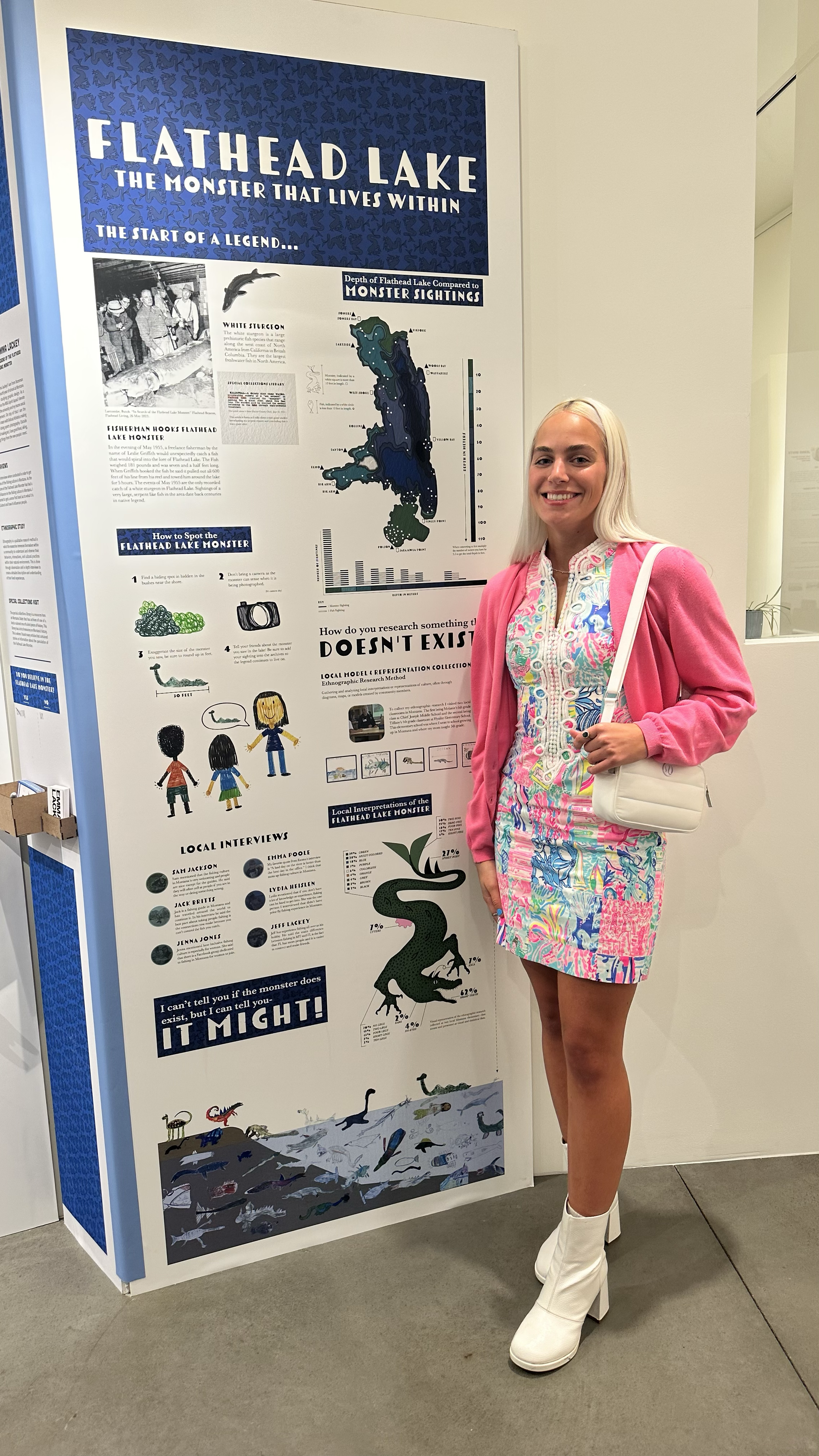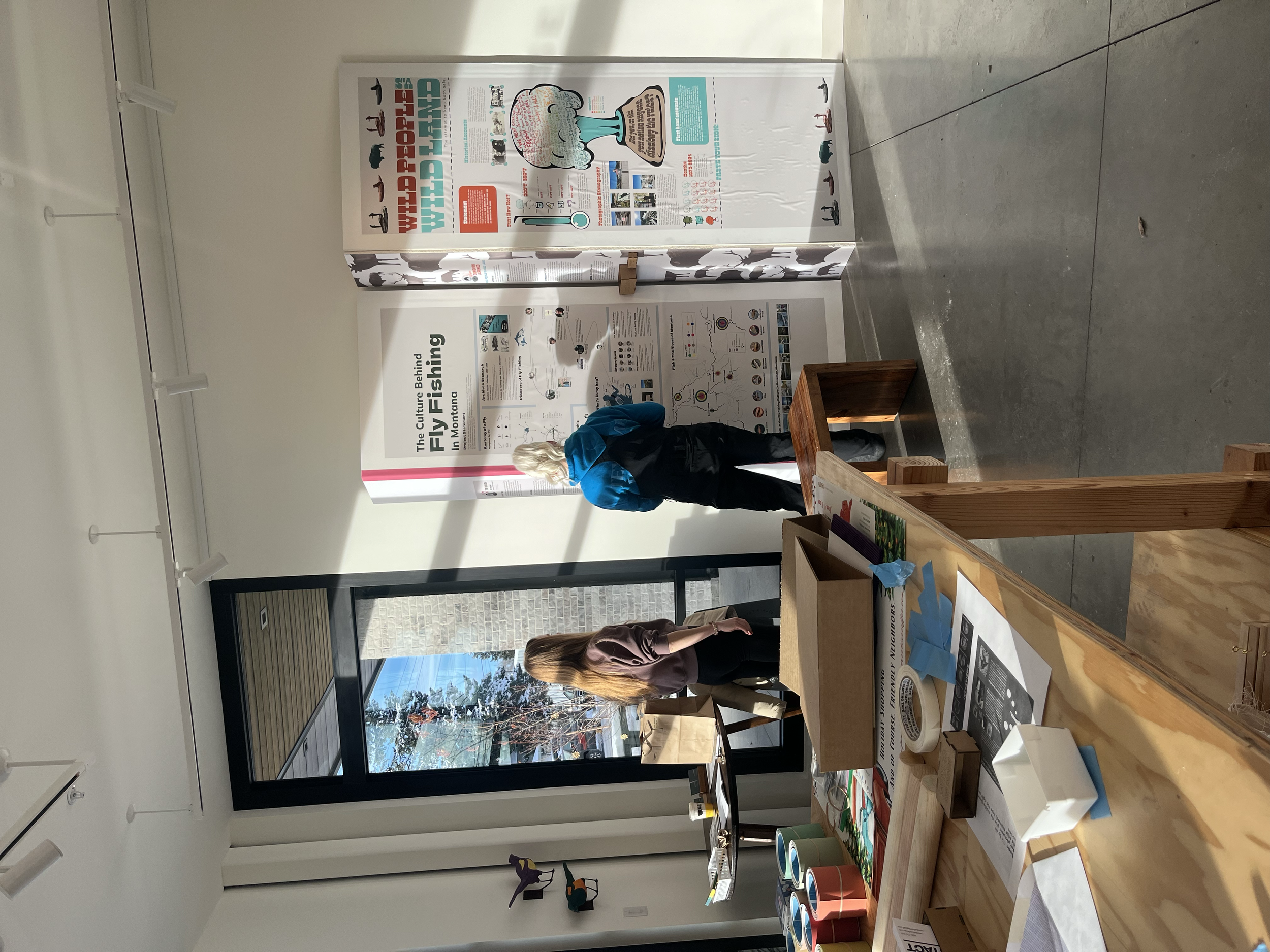Ethnographic Research
For a Cultural Heritage Theme
The objective of this project was to conduct extensive research on a cultural heritage theme in Montana, specifically focusing on "The Legend of the Flathead Lake Monster." This legend is a significant aspect of Montana's folklore and represents an element of intangible culture, originating from Polson, Montana, and the expansive lake that surrounds it. To gather comprehensive information, we utilized the Special Collections Library at Montana State for in-depth research and employed ethnographic research methods. The final deliverables of this project include a personal journal documenting our findings and a formal presentation. The research compiled will serve as a foundation for future projects.
Ethnographic research journal


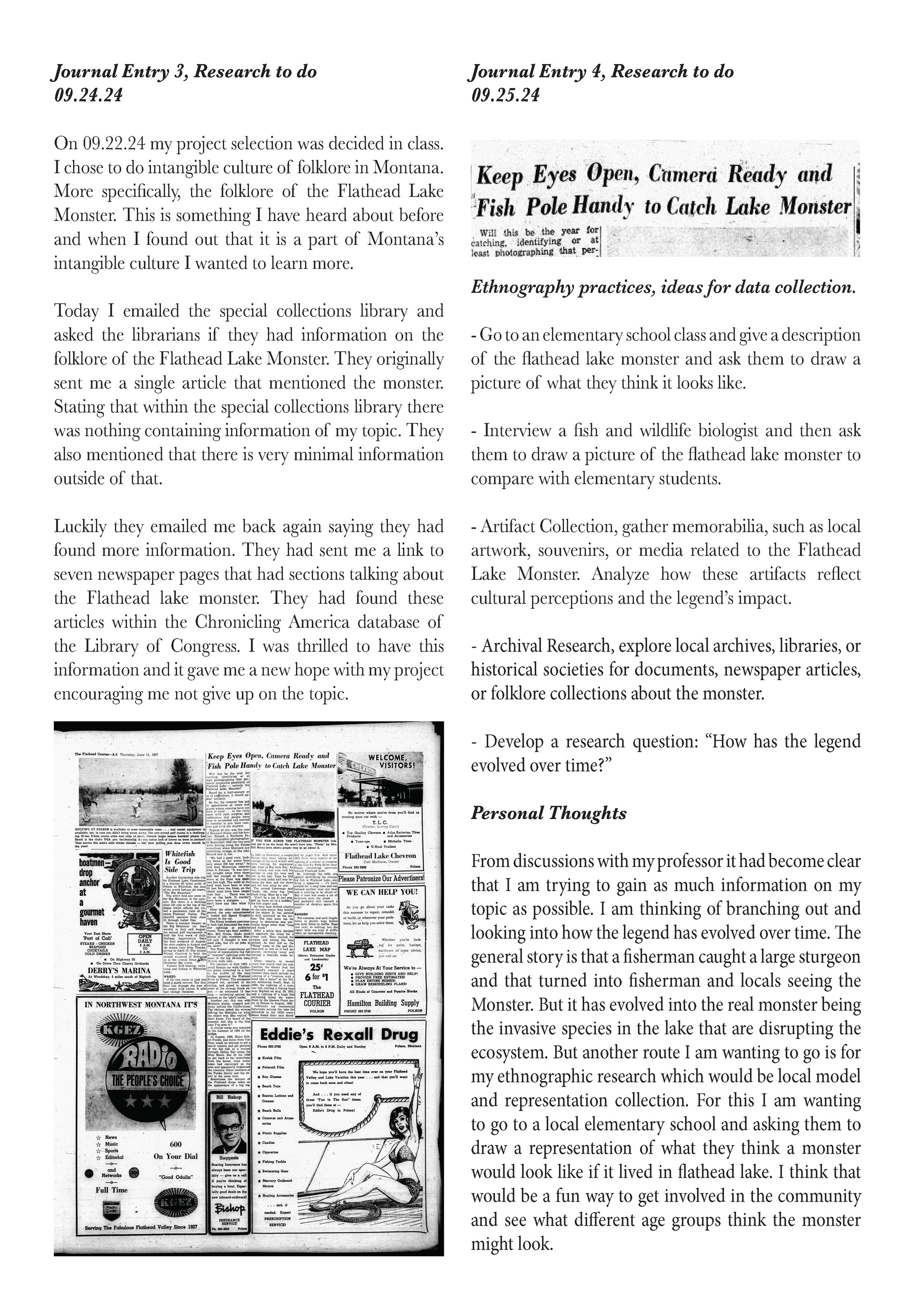


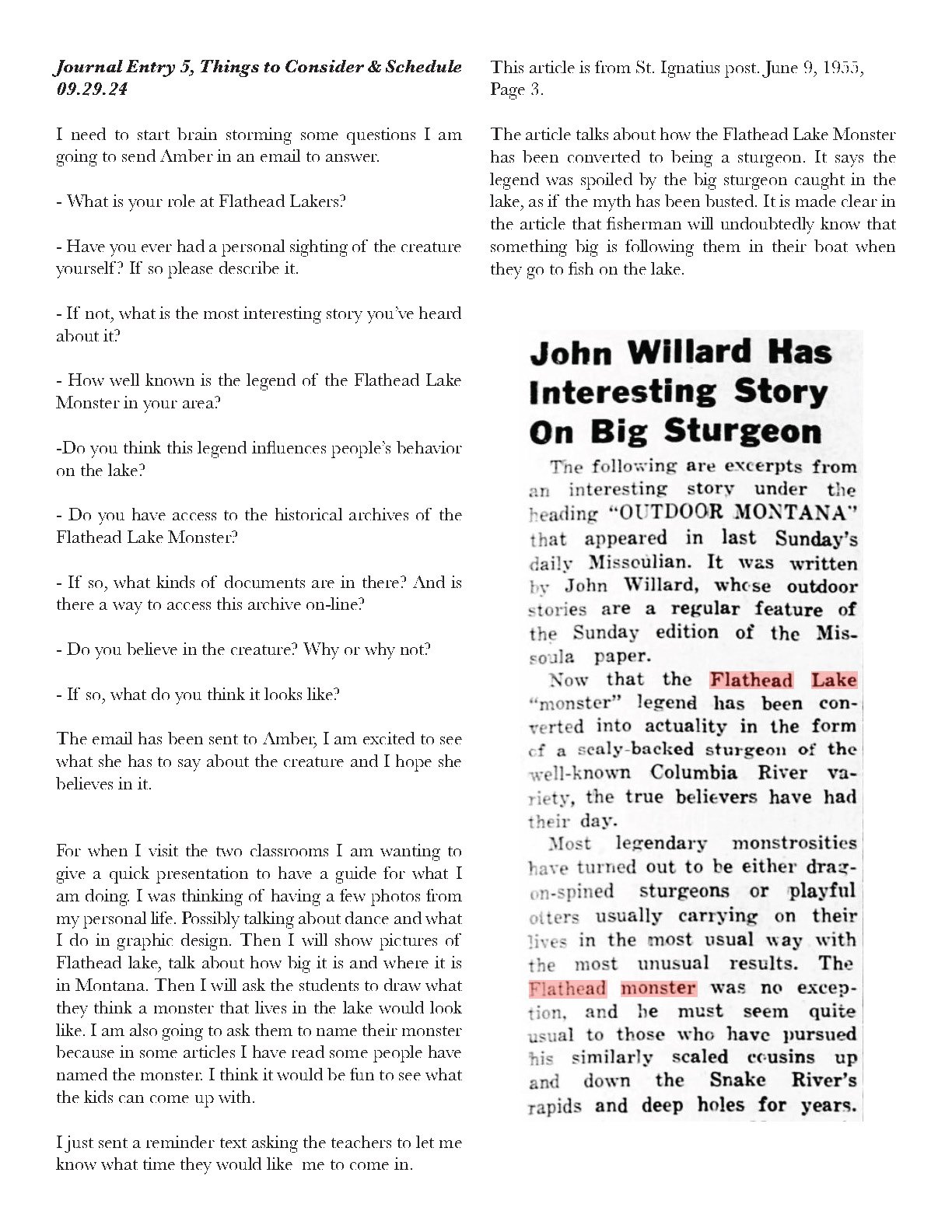










Ethnographic Research Presentation
Includes speaker notes at the bottom of the slides

Today I am presenting on the Ethnographic research I did for my cultural heritage theme.

For this project there were three different types of culture, we could choose to research where tangible culture, intangible culture, and natural heritage. Within these categories were subtopics. These 6 subtopics were the ones I was bouncing around with until I landed on one.

The Legend of the Flathead Lake Monster. This is a part of Montana's folklore and is under the category of Intangible culture. The definition of folklore is traditional beliefs, customs, and stories of a community passed through generations by word of mouth.

Events of May 1955, Leslie Griffiths sturgeon starting flathead lake lore, battling the fish for 5 hours, 7 1/2 feet 181 pounds

The events in May of 1955 are the only reported catch of a white sturgeon in the Flathead Lake. Sightings of a very large, serpent-like fish date back centuries in native legend. The "Griffith Sturgeon" has sparked the fascination and skepticism that has continued for decades on. The fish caught by Griffith is mounted to the wall of a museum in Polson still available for visitors to see today. This museum is the Polson-Flathead Historical Museum.

When trying to find more historical information about my topic I emailed the special collections library in hopes that they would have something in-house for me to look at. They didn't and sent me a single article that mentioned the monster and got back to me with 6 more articles from the Library of Congress that talked about the Flathead Lake monster.

The article talks about how the Legend of the Flathead Lake Monster is just a gemic for the Polson area to bring in more money and get more funding. It says that they are using the fact that they have such a big lake that allows them to use people's imaginations to their advantage. Saying other lake towns don’t have that luxury.

This was so interesting to me as it is about a game warden who needed to investigate reports of a “sea monster” in Flathead Lake. The game warden reported the monster was “nothing but a giant otter, about five feet long.” Which he said he saw through his binoculars. Which honestly seems more crazy to me than a sea monster.

The article talks of enthusitis wanting to try to photograph the flathead lake monster. You can also see pictured above a fisherman petting the "monster." the ariticle says and quote "If you run acros the flathead monster fish, just pat it on the head. He won't hurt you."

The article mentions that the “sea monster” is much larger than expected. People now think it is 14-20 feet in length and weighing upwards of a ton. Big Fish Unlimited is still present and continuing their award for catch of a lifetime.

The article talks about how the Flathead Lake Monster has been converted to being a sturgeon. It says the legend was spoiled by the big sturgeon caught in the lake, as if the myth has been busted. It is made clear in the article that fisherman will undoubtedly know that something big is following them in their boat when they go to fish on the lake.

An annual effort to catch the Flathead Lake Monster. It talks of fishermen using whole chickens and large chunks of liver in an attempt to catch it. There have been minimal sightings and no one is sure if it is even a fish or not. Some people think that it is a sturgeon, the same type of fish that Griffith had caught. The article even mentions that older locals recall hearing Native Americans telling stories of seeing a super-fish.

I conducted 6 local interviews to try to understand more about the fishing culture within Montana. I had never fly fished before and I knew that was the main type of fishing you need to do here to catch trout. After interviewing each person I asked them to send me their favorite picture of them fishing.

Sam, is a local who sees fly fishing as a hobby. Sam said the fishing culture in Bozeman is not welcoming especially when guides yell at you. This was ironic considering the next person I interviewed was a fishing guide. That leads me to my interview with Jack, he is a fishing guide in MT and travels all over for it. This was my most insightful interview because he gave me a new perspective on fishing.

Emma grew up bass fishing with her family and said when she tried to fly fishing here in Montana she ran out of luck. She also mentioned how the fishing culture is not inclusive here and is hard to get into. Jenna said she has met a lot of interesting people fly fishing and that some of her best stories come from it. Overall, her experience with the culture has been very welcoming.

Lydia is the only person I interviewed who doesn't fly fish. Lydia, sees it as something fun to do with friends but is very intimidated to try to get into fly fishing because of the technique needed and the culture. The last person I interviewed was my Dad. He spent years fishing in Montana and fished every day in Florida. Everyone is very nice & you're able to make friends a lot easier in Florida

From my interviews, I gathered that overall the fishing culture in Montana is very welcoming, although sometimes you might find yourself running into the wrong person in a fly shop or on the river which can skew your experience. I also learned the techniques that go into fly fishing and how different bugs have different patterns.

Now I will be getting into my ethnographic research. So you might be wondering... How do you research something that doesn't exist? Well, let me tell you-

I was inspired to do a Local Model and Representation Collection for my research from the reading Ethnographic Research Methods, by Brenda Laurel. This means that I would collect my research by Gathering and analyzing local interpretations or representations of culture, often through diagrams, maps, or models created by community members.

What better way to collect local interpretations than from the students with the brightest imaginations? Visit 2 local classrooms in Montana. Quick presentation with the first slide about myself. Following ones to explain the legend. I ensured not to include any leading images of what the monster could look like because I wanted this to be their interpretation of what it might look like.

The first classroom I visited was Melanie Bergeson's classroom, a 6th-grade class at Chief Joseph Middle School. After giving my quick presentation the kids were eager to get to work. I was walking around as they were all working. Checking in and asking them questions that might spark their imagination.
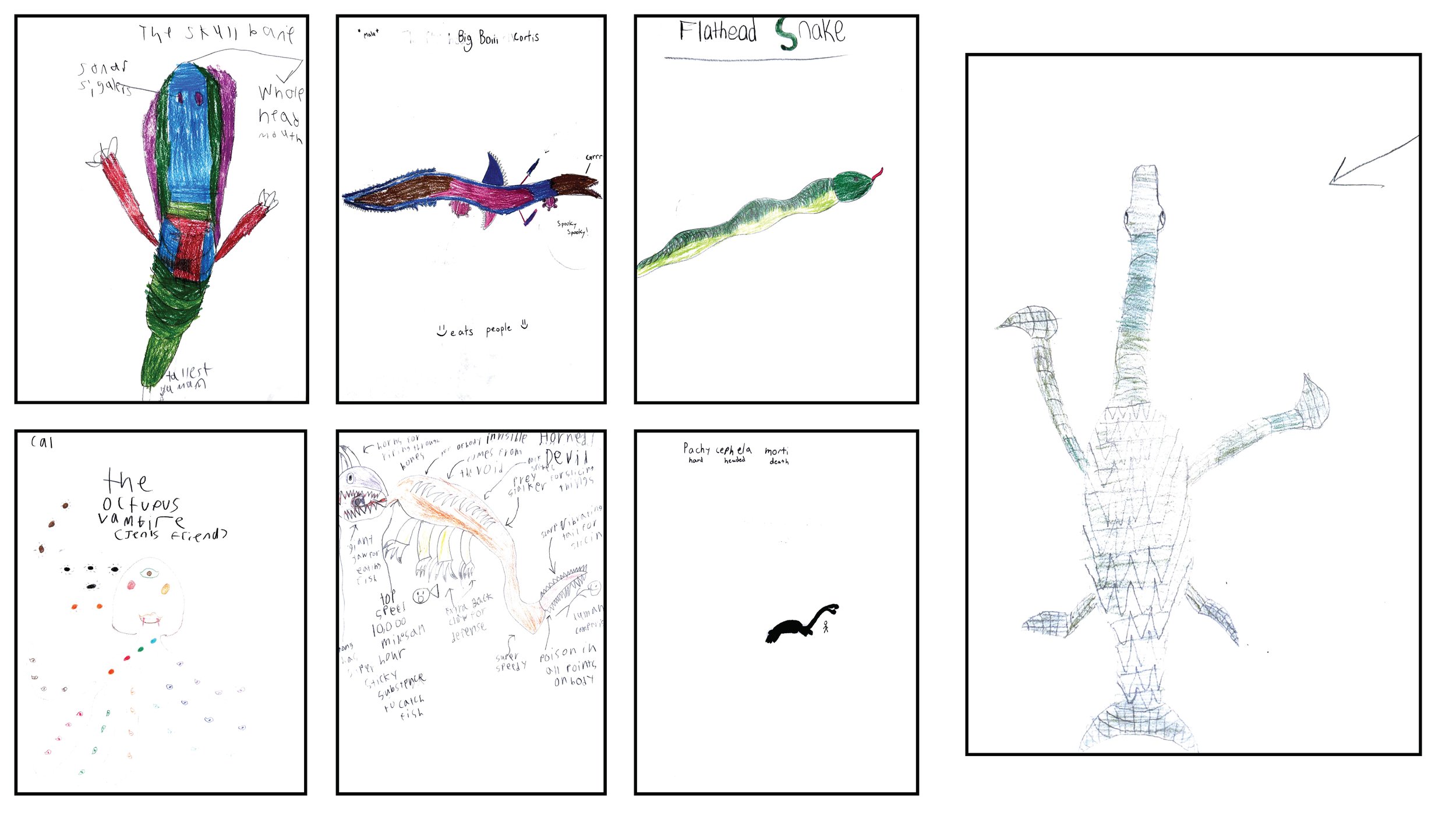
And here is a look at their work. The bottom left, octopus with eyes on its tentacles stands out to me and is very unique. I also love the detail and fins of the one on the right.

As I am going through these it is also fun to look at the different names each student came up with. I asked them to do this since the Flathead Lake monster has had a few different names thrown out there but it hasn't landed on one yet.

I love Jerimia in the top left. as well as the one that is on the bottom in the middle, the student came up with two options and one of them is a clear jellyfish that is a mile long and that is why not very many people have seen it.

These were a few of the interpretations that stood out to me because of both their rendering and their unique traits.

The second classroom I visited was Tiffany Luke's 4th grade classroom at Hyalite Elementary School. This was the elementary school I attended when I lived here so it was fun to go back.

I love the one in the top left that mentions how the student thinks the monster is a massive platypus that is 150 feet long.

out of all of these, I love the angler fish in the bottom left corner I thought that was a smart idea.

These were the student's work that stood out to me from the 4th-grade class. The bottom left one was the first mermaid interpretation I saw and the bottom middle is a monster without eyes and it only has big ears to hear well.

Visiting these two local classrooms was so much fun. I loved answering all of the questions of whether I had seen the monster and if I thought it existed. The interpretations I was able to collect are all unique in their own way and no two are the same. I am excited to see where all of this research takes me.

Now I can't tell you if the Flathead Lake Monster does exist, but I can tell you it might. Thank you!
Research Exhibition
The Eco Arts Museum located here in Bozeman Montana held my classes art and research exhibition. Part of this process included installing and setting up a gallery space with other classmates work.
